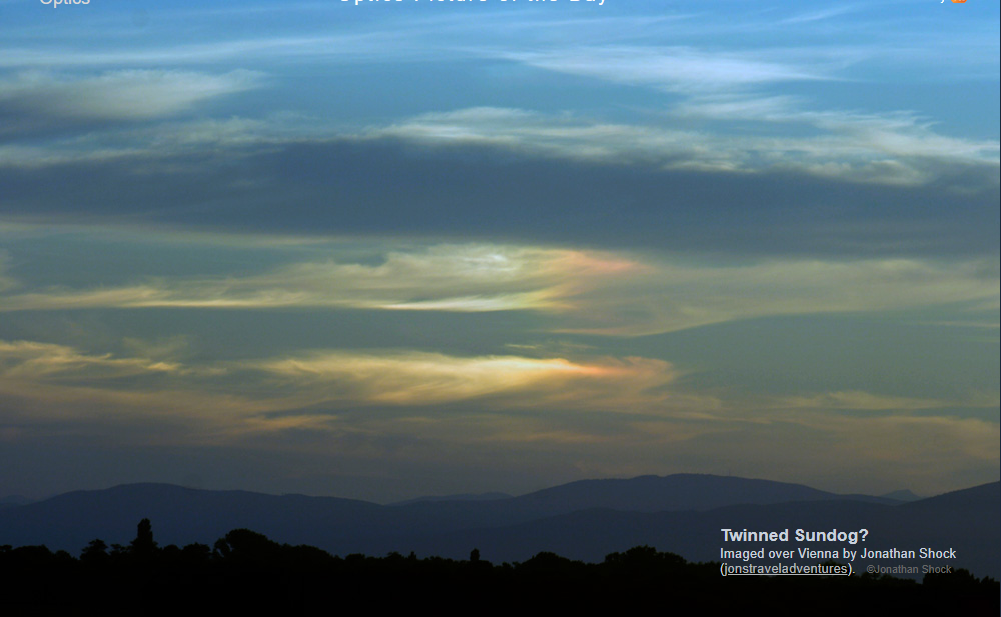OPOD - Twinned sundog?
OPOD - Twinned Sundog: A Spectacular Atmospheric Phenomenon
Have you ever witnessed a mesmerizing celestial spectacle in the sky that left you in awe? One such captivating phenomenon is the twinned sundog. Often mistaken for separate entities, these "twins" are actually part of the same sundog, formed by plate crystals wobbling slightly from their normal horizontal alignment. In this article, we will delve deeper into the intricacies of this stunning atmospheric optics display.
What is a Sundog?
Before we explore the concept of a twinned sundog, let's first understand what a sundog is. Sundogs, also known as parhelia, are optical phenomena that occur when sunlight interacts with ice crystals in the atmosphere. These crystals can be found in high-altitude clouds, such as cirrus clouds. Sundogs typically appear as bright spots of light on either side of the sun, often forming a halo-like shape.
The Formation of a Twinned Sundog
The phenomenon of a twinned sundog occurs when plate-shaped ice crystals within the clouds wobble slightly from their usual horizontal alignment. This deviation causes the sundog to split into two distinct sections, creating the illusion of separate entities. If the crystal-bearing clouds were continuous, we would witness the full extent of the sundog. However, due to the separate clouds lighting up, we only see sections of the sundog.
Various Shapes and Guises
Sundogs are renowned for their diverse shapes and appearances. While the twinned sundog is one variation, there are several other types that can be observed. These include:
- Parhelic circles: Complete circles formed by the interaction of sunlight with ice crystals.
- Sun pillars: Vertical columns of light extending above or below the sun.
- Circumzenithal arcs: Colorful arcs that appear above the sun, resembling an upside-down rainbow.
- Upper tangent arcs: Arcs of light that touch the top of the sundog and extend outward.
- Lower tangent arcs: Arcs of light that touch the bottom of the sundog and extend outward.
The Beauty of Atmospheric Optics
Atmospheric optics, the study of how light interacts with the Earth's atmosphere, offers a fascinating glimpse into the wonders of nature. The intricate interplay between sunlight and ice crystals creates a kaleidoscope of colors and shapes in the sky. From vibrant rainbows to elusive halos, these optical phenomena never fail to captivate our imagination.
Capturing the Magic
Photographers and sky enthusiasts alike are often drawn to the allure of atmospheric optics. The unique and ethereal nature of these phenomena makes them a favorite subject for photographers seeking to capture the beauty of the natural world. Whether it's using specialized equipment or simply relying on their keen eye, these individuals strive to immortalize the fleeting moments of these celestial displays.
The Science Behind Sundogs
Understanding the science behind sundogs and other atmospheric optics phenomena requires delving into the principles of light refraction and reflection. When sunlight passes through ice crystals, it bends and refracts, resulting in the separation of colors and the formation of halos and arcs. The specific angles at which light is refracted determine the shape and position of these optical phenomena in the sky.
Unveiling the Mysteries
While scientists have made significant strides in unraveling the secrets of atmospheric optics, there is still much to learn about these captivating displays. Ongoing research and technological advancements continue to shed light on the intricate mechanisms behind these phenomena. By studying the behavior of light and ice crystals in various atmospheric conditions, scientists hope to unlock further insights into the mysteries of our ever-changing skies.
A Reminder of Nature's Splendor
Encountering a twinned sundog or any other atmospheric optics spectacle serves as a reminder of the incredible beauty that surrounds us. These natural phenomena remind us of the intricate workings of our planet and the vastness of the universe. They inspire awe and wonder, inviting us to pause for a moment and appreciate the sheer magnificence of the world we inhabit.
Conclusion
The twinned sundog is a breathtaking example of the marvels of atmospheric optics. From its formation by wobbling ice crystals to its various shapes and guises, this celestial display never fails to captivate those fortunate enough to witness it. As we continue to explore and understand the science behind these phenomena, let us cherish the moments when nature reveals its splendid secrets, reminding us of the boundless wonders that await us in the skies above.

Twinned Sundog?
Imaged over Vienna by Jonathan Shock (jonstraveladventures). ©Jonathan Shock
These �twins� are part of the same relatively tall sundog produced by plate crystals wobbling a degree or so from their normal horizontal alignment. We would see the full extent of the �dog� if the crystal bearing clouds were continuous. As it is the two separate clouds separately light up to show sections of the sundog. Sundogs appear in many shapes and guises.
Note: this article has been automatically converted from the old site and may not appear as intended. You can find the original article here.
Reference Atmospheric Optics
If you use any of the definitions, information, or data presented on Atmospheric Optics, please copy the link or reference below to properly credit us as the reference source. Thank you!
-
<a href="https://atoptics.co.uk/blog/opod-twinned-sundog/">OPOD - Twinned sundog?</a>
-
"OPOD - Twinned sundog?". Atmospheric Optics. Accessed on November 26, 2024. https://atoptics.co.uk/blog/opod-twinned-sundog/.
-
"OPOD - Twinned sundog?". Atmospheric Optics, https://atoptics.co.uk/blog/opod-twinned-sundog/. Accessed 26 November, 2024
-
OPOD - Twinned sundog?. Atmospheric Optics. Retrieved from https://atoptics.co.uk/blog/opod-twinned-sundog/.